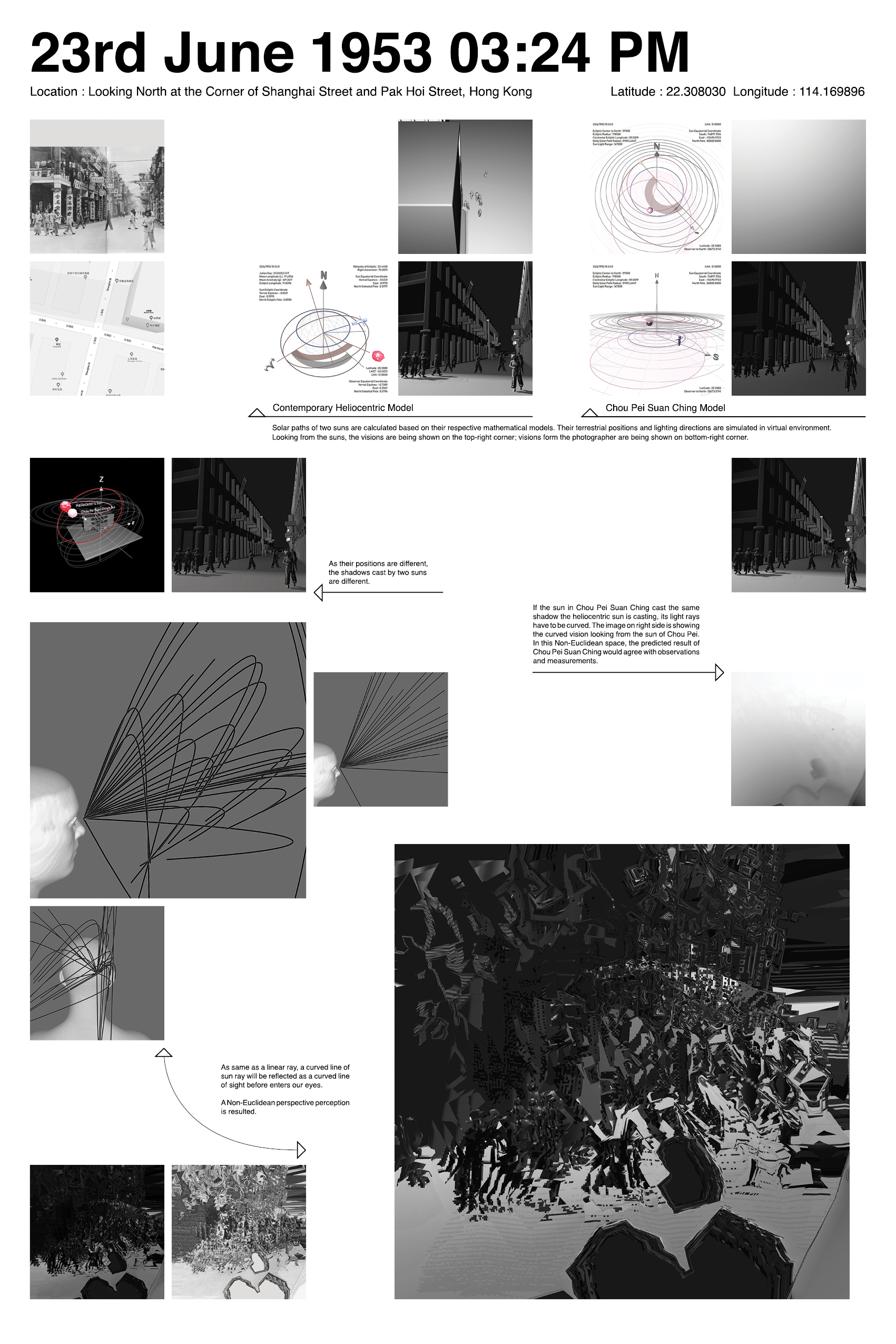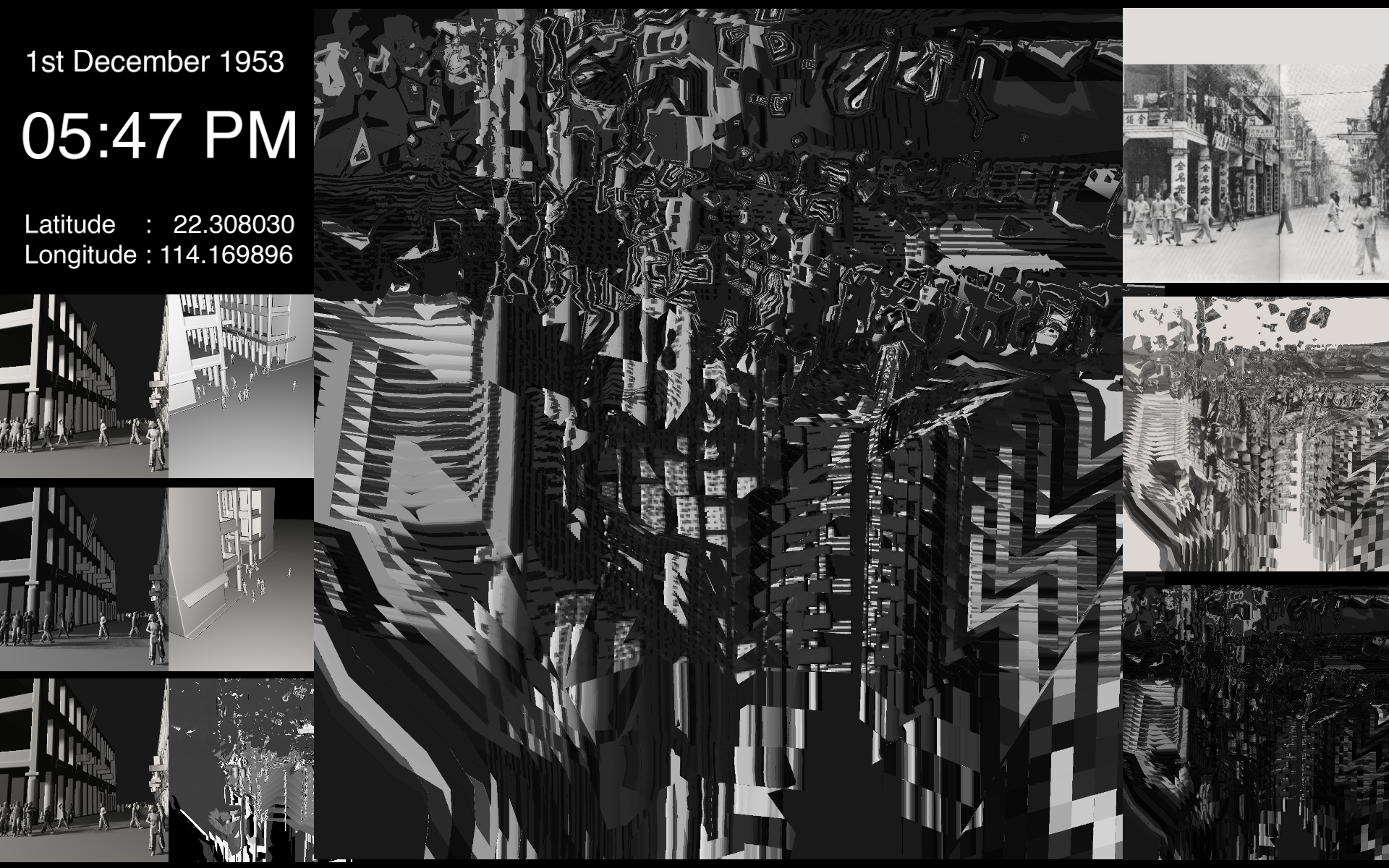
Year : 2018
Title : Sun Shines 83500 km
Media : Generated Media Graphic
Background :
This project was initialed by my study of alternative cosmology documented in an ancient Chinese mathematics treatise called “Chou Pei Suan Ching (周髀算經)”. The universe described was totally different from the one we all know today. Both the earth and sky were flat circular plates, which were separated from each other in 80000li (里) (~40000km). Both had a cone protruded from the center and pointed to the North Pole. Sun and other celestial bodies moved around the pole axis in seven circular orbits. Such kind of Canopy-Heavens hypothesis (蓋天說) was actually popular in ancient time. For example, the Earth was a flat dome in Hindu cosmology. It was supported by four elephants resting on back of a turtle. However, most of these ancient cosmologies were told in mythological tales. What makes Chou Pei Suan Ching special is its scientific and mathematical nature.
Pei (髀) was a 8 chě (尺) (~23.1 cm) long rod. It was used as the gnomon of sundial. If it was moved 1000 li (里) toward sun from the original standing location, its casting shadow would be reduced by 1 cun (寸) (~2.31cm) length. That was the most important theorem defined in Chou Pei Suan Ching (i.e. 日影千里差一寸). Other variables of universe could be calculated by this theorem. For example, the height of sky was 80000 li (里), the radius of earth was 405000 li (里), and the diameter of sun was 1250 li (里). This theorem was deducted by its own proof Pythagorean theorem (勾股定理), as well as an axiom, which assumed that sky and earth were two parallel planes. Nowadays, we know that this axiom is “wrong”, and its deducted theorem fails to match experimental observations. The shadow length would not be changed as expected. However, it is still a self-contained mathematical model.
Artist Statement:
Scientists deduct mathematical models to explain our experiences. Shall artists act in reverse direction? This project aims at twisting visual experience, at least an alternative perspective representation, to match an abandoned mathematical model. In my visual study, an algorithm was devised to twists the light rays whatever necessary, so that the sun of Chou Pei would be casting right shadows, which agree with contemporary heliocentric model. It means that if observations were agreed with prediction, then Chou Pei's universe must be a non-Euclidean space, where ancient people saw in curved lines of sight.
Since human perception, as well as concept of space, might have evolved over time. Space does not exist. It has never been objective truth but mental concept. When we saw an object around, we were not given form and depth immediately. That is our brain to fill in the blank. Our perception is influenced by memory, imagination, knowledge and culture. It generally forms a concept of space. The concept is then further solidified by geometry in mathematical model, which returns to feed our perception. Thus, everything appears so evident in reinforcing loop. In the spirit of critique, it is necessary to queries the authorization of our space perception, and expand our visual dimensions.
Project Description:
A three-dimensional space is built in virtual environment. Any object within receipts light and casts shadow. Two light sources (virtual suns) are calculated based on two different models: the contemporary heliocentric model and the Chou Pei Suan Ching model. Comparing their lighting directions, shadow shape and dimension, none of the above would be matched. With a view to match, instead of traditional linear perspective, a Non-Euclidean space is created with curved lines of light rays, as well as curved lines of sight. It generates an unexpected and distorted visual rendering. The lines are not curved in universal but somehow chaotic forms. However, they are not generated randomly, but based on my own devised algorithm. The algorithm does whatever necessary to twists the light ray, so that the predicted result of Chou Pei Suan Ching could agree with observations again, i.e. casting the right shadows, at least in my Non-Euclidean representation.
In last exhibition, this distorted line of sight is applied to re-draw an everyday scene of a Hong Kong street in 1953. Based on an old postcard, the street is remade on my virtual stage. Since the date and time are known, the positions of suns could be calculated; then, the moments will be rendered in my algorithm. I wonder how the moment would be represented in an alternative perception.





